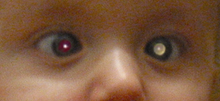| Leukocoria | |
|---|---|
| Other names | Leucocoria,[1] white pupillary reflex |
 | |
| A child with leukocoria due to retinoblastoma in the left eye | |
| Specialty | Ophthalmology, pediatrics |
Leukocoria (also white pupillary reflex) is an abnormal white reflection from the retina of the eye. Leukocoria resembles eyeshine, but leukocoria can also occur in animals that lack eyeshine because their retina lacks a tapetum lucidum.
Leukocoria is a medical sign for a number of conditions, including Coats disease, congenital cataract, corneal scarring, melanoma of the ciliary body,[2] Norrie disease, ocular toxocariasis, persistence of the tunica vasculosa lentis (PFV/PHPV), retinoblastoma, and retrolental fibroplasia.
Because of the potentially life-threatening nature of retinoblastoma, a cancer, that condition is usually considered in the evaluation of leukocoria. In some rare cases (1%) the leukocoria is caused by Coats' disease (leaking retinal vessels).
- ^ thefreedictionary.com
- ^ Demirci H, Shields CL, Shields JA, Honavar SG, Eagle RC (January 2001). "Leucocoria as the presenting sign of a ciliary body melanoma in a child". The British Journal of Ophthalmology. 85 (1): 115–6. doi:10.1136/bjo.85.1.110f. PMC 1723667. PMID 11201946.